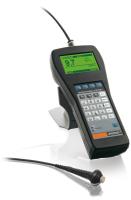 Add My Company
Add My Company
Sign In
Electrical conductivity medical devices
09-10-2015

Electrical conductivity is a quality check solution for non ferromagnetic metals and is used in determining material properties. A different application has been found in the detection of hairline cracks in bearings for x-ray medical devices. The components of medical devices are subject to very stringent safety and quality requirements with the flawless functioning of these bearings depending on, among other things, the quality of their surfaces. All defects in those surfaces, even the finest hairline cracks, should be ruled out and electrical conductivity does this.
Bearings, such as those used for holding and smoothly moving the X-ray tubes in medical devices, are actually gliding on a thin film of liquid. If the surfaces have any damage, such as the thin fractures that can occur during the machining of the components, the sliding properties cannot be ensured for the device’s entire service lifetime. Technically, such cracks near the surface are difficult to detect, as optical inspection methods very quickly reach their limits with fine hairline cracks. However, measuring the electrical conductivity of the material provides a simple and quick way to detect even tiny fissures, as this method is very sensitive to structural inconsistencies.
FISCHER’s mobile handheld instrument SIGMASCOPE® SMP10, used together with the probe ES40, non- destructively measures the electrical conductivity of non- ferrous metals extremely quickly and precisely using the phase-sensitive eddy current method, which produces exactly the right conditions required for crack detection.
To check a surface for cracks, the probe ES40 is passed over the surface of the sample in free-running mode. Eddy currents are formed in the material, which are in turn recorded by the probe and converted to a signal in the instrument. In the case of the bearings we examined as a test, the conductivity measured was in the range of
18.3 MS/m, with very low variation. Any hairline cracks in the material will hinder the spread of the eddy currents – even the very finest, optically invisible faults. In practice, when the tested bearings showed a value of e.g. 14 MS/m, that would clearly indicate that a crack had been found by means of electrical conductivity.
The probe ES40 has a range of measurement frequencies (60-480 kHz), making it suitable for different material thicknesses. Using a lower measurement frequency results in the eddy current field penetrating deeper into the sample material. The measurements on the bearings described above were carried out using the probe’s highest frequency of 480 kHz, thus looking specifically for damage in the material near the surface. For use on tiny parts, the optional probe ES24, which has a smaller measuring head than the ES40, is recommended.
For the detection of fine hairline cracks in slide bearings produced for use in medical X-ray equipment, measuring the electrical conductivity – as implemented in the SIGMASCOPE® SMP10 from FISCHER – is an excellent solution. And between the two probes ES40 and ES24, a wide variety of part geometries can be accommodated flexibly, completing the ideal system for this purpose. For more information, please contact Fischer Instrumentation GB Ltd 01590 684100
For more information on Electrical conductivity medical devices talk to Fischer Instrumentation
Enquire Now
List your company on FindTheNeedle.
